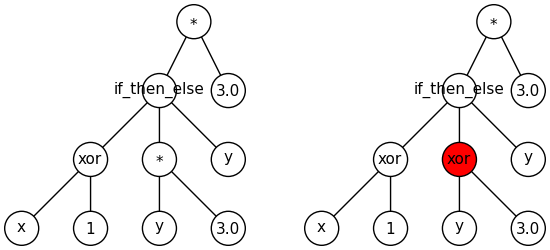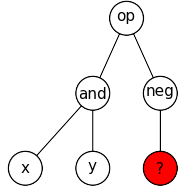Navigation
- index
- modules |
- next |
- previous |
 Project Homepage »
Project Homepage »- DEAP 0.9.2 documentation »
- Tutorial »
Genetic programming is a special field of evolutionary computation that aims at building programs automatically to solve problems independently of their domain. Although there exists diverse representations used to evolve programs, the most common is the syntax tree.

For example, the above figure presents the program  . For this tree and further examples, the leaves of the tree, in green,
are called terminals, while the internal nodes, in red, are called
primitves. The terminals are divided in two subtypes, the
constants and the arguments. The constants remain the same for the entire
evolution while the arguments are the program inputs. For the last
presented tree, the arguments are the variables
. For this tree and further examples, the leaves of the tree, in green,
are called terminals, while the internal nodes, in red, are called
primitves. The terminals are divided in two subtypes, the
constants and the arguments. The constants remain the same for the entire
evolution while the arguments are the program inputs. For the last
presented tree, the arguments are the variables  and
and  , and
the constant is the number
, and
the constant is the number  .
.
In DEAP, user defined primitives and terminals are contained in a primitive set. For now, there exists two kinds of primitive set, the loosely and the strongly typed.
Loosely typed GP does not enforce specific type between the nodes. More specifically, primitives’ arguments can be any primitives or terminals present in the primitive set.
The following code define a loosely typed PrimitiveSet for the previous tree
pset = PrimitiveSet("main", 2)
pset.addPrimitive(max, 2)
pset.addPrimitive(operator.add, 2)
pset.addPrimitive(operator.mul, 2)
pset.addTerminal(3)
The first line creates a primitive set. Its argument are the name of the procedure it will generate "main" and its number of inputs, 2. The next three lines add function as primitives. The first argument is the function to add and the second argument the function arity. The last line adds a constant terminal. Currently the default names for the arguments are "ARG0" and "ARG1". To change it to "x" and "y", simply call
pset.renameArguments(ARG0="x")
pset.renameArguments(ARG1="y")
In this case, all functons take two arguments. Having a 1 argument negation function, for example, could be done with
pset.addPrimitive(operator.neg, 1)
Our primitive set is now ready to generate some trees. The gp module contains three prefix expression generation functions genFull(), genGrow(), and genRamped(). Their first argument is a primitive set and they return a valid prefix expression in the form of a list of primitives. The content of this list can be read by the PrimitiveTree class to create a prefix tree.
expr = genFull(pset, min_=1, max_=3)
tree = PrimitiveTree(expr)
The last code produces a valid full tree with height randomly chosen between 1 and 3.
In strongly typed GP, every primitive and terminal is assigned a specific type. The output type of a primitive must match the input type of another one for them to be connected. For example, a primitive can return a boolean and this value is guaranteed to not be multipled with a float if the multiplication operator operates only on floats.
def if_then_else(input, output1, output2):
return output1 if input else output2
pset = PrimitiveSetTyped("main", [bool, float], float)
pset.addPrimitive(operator.xor, [bool, bool], bool)
pset.addPrimitive(operator.mul, [float, float], float)
pset.addPrimitive(if_then_else, [bool, float, float], float)
pset.addTerminal(3.0, float)
pset.addTerminal(1, bool)
pset.renameArguments(ARG0="x")
pset.renameArguments(ARG1="y")
In the last code sample, we first define an if then else function, that returns the second argument if the first argument is true and the third one otherwise. Then, we define our PrimitiveSetTyped. Again, the procedure is named "main". The second argument defines the input types of the program, here "x" is a bool and "y" is a float. The third argument defines the output type of the program, a float. Adding primitives to this primitive now requires to set the input and output types of the primitives and terminal. For example, we define our "if_then_else" function first argument as a boolean, the second and third argument have to be floats. The function is defined as returning a float. We now understand that the multiplication primitive can only have the terminal 3.0, the if_then_else function or the "y" as input, which are the only floats defined.
The preceding code can produce the tree on the left but not the one on the right because the type restrictions.

Note
The generation of trees is done randomly while making sure type constraints are respected. If any primitive as an input type that no primitive and terminal can provide, chances are that this primitive will be picked and placed in the tree, resulting in the imposibility to complete the tree within the limit fixed by the generator. For example, when generating a full tree of height 2, suppose "op" takes a boolean and a float, "and" takes 2 boolean and "neg" takes a float, no terminal is defined and the arguments are booleans. The following situation will occur where no terminal can be placed to complete the tree.

In this case, DEAP raises an IndexError with the message "The gp.generate function tried to add a terminal of type float, but there is none available."
An ephemeral constant is a terminal encapsulating a value that is generated
from a given function at run time. Ephemeral constants allow to have terminals
that don’t have all the same values. For example, to create an ephemeral constant
that takes its value in  we use
we use
pset.addEphemeralConstant(lambda: random.uniform(-1, 1))
The ephemeral constant value is determined when it is inserted in the tree and never changes unless it is replaced by another ephemeral constant. Since it is a terminal, ephemeral constant can also be typed
pset.addEphemeralConstant(lambda: random.randint(-10, 10), int)
The code presented in the last two sections produce valid trees. However, as in the Next Step Toward Evolution tutorial, these trees are not yet valid individuals for evolution. One must combine the creator and the toolbox to produce valid individuals. We need to create the Fitness and the Individual classes. To the Individual, in addition to the fitness we add a reference to the primitive set. This is used by some of the gp operators to modify the individuals.
creator.create("FitnessMin", base.Fitness, weights=(-1.0,))
creator.create("Individual", gp.PrimitiveTree, fitness=creator.FitnessMin,
pset=pset)
We then register the generation functions into a Toolbox.
toolbox = base.Toolbox()
toolbox.register("expr", gp.genFull, pset=pset, min_=1, max_=3)
toolbox.register("individual", tools.initIterate, creator.Individual,
toolbox.expr)
Calling toolbox.individual() readily returns an individual of type PrimitiveTree.
In DEAP, trees can be translated to readable Python code and compiled to Python code object using functions provided by the gp module. The first function, stringify() takes an expression or a PrimitiveTree and translates it into readable Python code. For example, the following lines generate a tree and output the code from the first example primitive set
>>> expr = genFull(pset, min_=1, max_=3)
>>> tree = PrimitiveTree(expr)
>>> stringify(tree)
'mul(add(x, x), max(y, x))'
Now, this string represents the program we just generated, but it cannot
yet be executed. To do so, we have to compile the expression to
Python code object. Since this function has two inputs, we wish
to compile the code into a callable object. This is possible with
lambdify(). The term lambdify comes from the fact that
it returns a lambda function corresponding to the code.
lambdify() takes two arguments, the expression to compile and
the associated primitive set.
The following example compiles the preceding tree and evaluates the resulting
function for  and
and  .
.
>>> function = lambdify(tree, pset)
>>> function(1, 2)
4
Finally, when the generated program has no input argument and terminals are functions, the expression can be compiled to byte code using the function evaluate(). An example of this sort of problem is the Artificial Ant Problem.
Since DEAP uses the Python parser to compile the code represented by the trees, it inherits from its limitations. The most commonly encountered restriction is the parsing stack limit. Python interpreter parser stack limit is commonly fixed between 92 and 99. This means that an expression can at most be composed of 91 succeeding primitives. In other words, a tree can have a maximum depth of 91. When the limit is exceeded, Python raises the following error
s_push: parser stack overflow
Traceback (most recent call last):
[...]
MemoryError
Since this limit is hardcoded in the interpreter, there exists no easy way to increase it. Furthermore, in GP this error commonly stems from a phenomema known as bloat. That is, the produced individuals have reached a point where they contain too much primitives to effectively solved the problem and the evolution stagnates. To counter this, DEAP provides different functions that can effectively maintain the size and height of the trees under an acceptable limit. These operators are listed in the GP section of Operators.
The different ways to evolve program trees are presented through the Genetic Programming (GP) examples.